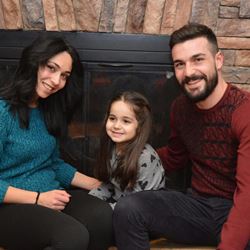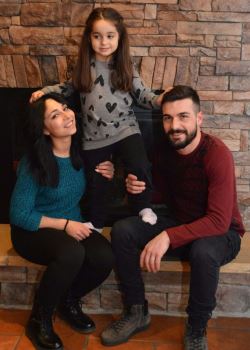You are here
Asia’s Cord Blood Story
 During the pregnancy with Asia, a friend of ours told us about cord blood banking. We were fascinated with the idea of storing our baby’s newborn stem cells, and we got in contact with Smart Cells International in Italy. They provided us with detailed information on the process and we decided to go ahead to give our child an extra opportunity.
During the pregnancy with Asia, a friend of ours told us about cord blood banking. We were fascinated with the idea of storing our baby’s newborn stem cells, and we got in contact with Smart Cells International in Italy. They provided us with detailed information on the process and we decided to go ahead to give our child an extra opportunity.
When our baby was born, Smart Cells arranged a courier who delivered the cord blood to their laboratory near London. The cells were immediately cryopreserved and in a few days’ time they advised us of the outcome with all the storage details. Shortly after her birth, we realised that Asia had problems standing up and fell easily.
In the beginning we thought this was normal, but in the following days and weeks, we realised that she was not improving. Even after a few months, she was still struggling. We had noticed that after about 10 steps, she started having difficulties. Even holding things with her hands was complicated as her movements were not fluid. As if this weren’t enough, Asia did not speak, and, generally, she wasn’t keeping up with other children.
We started to worry so we took Asia to different practitioners, but all of them told us that besides seeing physiotherapists and speech therapists, there was nothing much we could do for her. We were told that Asia would most likely need injections of botulinum toxin in the future to help her. We could not accept that; we wanted to do more.
At the age of two, we took Asia to an orthopedist who diagnosed Asia with a mild spastic tetraparesis due to lack of oxygen at birth. He also told us that, while there is no cure as of today for this disease, physiotherapy could help to diminish the inflammation of the muscles. He also suggested that we use the stem cells we had stored at birth.
We therefore called the Italian office of Smart Cells to make them aware of the problem and they told us that in similar cases, other children had benefited from the infusion of their own stem cells. We did, however, need to speak with Duke University of North Carolina, in the United States, to see if it we could have the treatment there. We relied on Smart Cells in Italy to help us with Duke, because of the language barrier. After a few months, arrangements were in place for the treatment and we left for the United States.
At Duke they were so thoughtful, caring and efficient. It was obvious that they had a huge amount of experience. They explained to us that there was a good chance that Asia would benefit from stem cell treatment but that she should continue to do physiotherapy or some type of sport. Everything went smoothly as planned. On the first day we went to the hospital for a check-up (we had already sent an MRI and Asia’s entire medical history) and on the second day the infusion of her cord blood stem cells took place. Asia had no pain or discomfort during the infusion, which lasted about 15 minutes. On the third day, we went back for further checks and they told us that everything was going well. They also explained that in a few months’ time we would see the first improvements, but after just two weeks Asia was starting to speak better, run and climb. It was obvious that she had greater strength in her arms and legs. It was all so amazing and we were so happy!
 The improvements continued and seven months later we went back to the orthopedist who is treating Asia and he said he had never seen such improvements in a child with this type of disease; the stiffness had almost completely gone out of her muscles. Even the physiotherapist who was treating Asia before the infusion noticed that her arms and legs were no longer rigid. The therapist told us that Asia no longer required the same type of physiotherapy and that she just needed to practice some sport. All this was happening under our very eyes and we were so happy, we could hardly believe it.
The improvements continued and seven months later we went back to the orthopedist who is treating Asia and he said he had never seen such improvements in a child with this type of disease; the stiffness had almost completely gone out of her muscles. Even the physiotherapist who was treating Asia before the infusion noticed that her arms and legs were no longer rigid. The therapist told us that Asia no longer required the same type of physiotherapy and that she just needed to practice some sport. All this was happening under our very eyes and we were so happy, we could hardly believe it.
During the first two weeks after the cord blood infusion, Asia experienced pain in her wrists and in her left ankle because the muscles were decontracting and this was somewhat painful.
Duke Medical Center explained that, based on their experience, on Asia’s weight and on the number of stem cells available, it would be advisable to do two infusions a few months’ apart one from the other. They had therefore decided to use only 60% of the cells for the first infusion and asked us to come back for a second infusion later. We returned to Duke Medical Center in February 2018 for a second infusion and, like the previous time, we managed to do everything easily in three days.
Asia is now four years old and she has just finished her second year of preschool and, even though she is the smallest in her class, she has managed to keep up with the other children. Asia is also attending a modern dance course and she participated in the end of the year show. She was so proud and happy, and so were we.
We now hope that Asia will keep on improving and we are grateful to Smart Cells for having given us the opportunity to change our daughter’s future. We are also especially thankful to Nadia Giacomini, Country Manager Smart Cells Italy, who has been so helpful from the beginning to the end of the process. We could not have done it without her.
